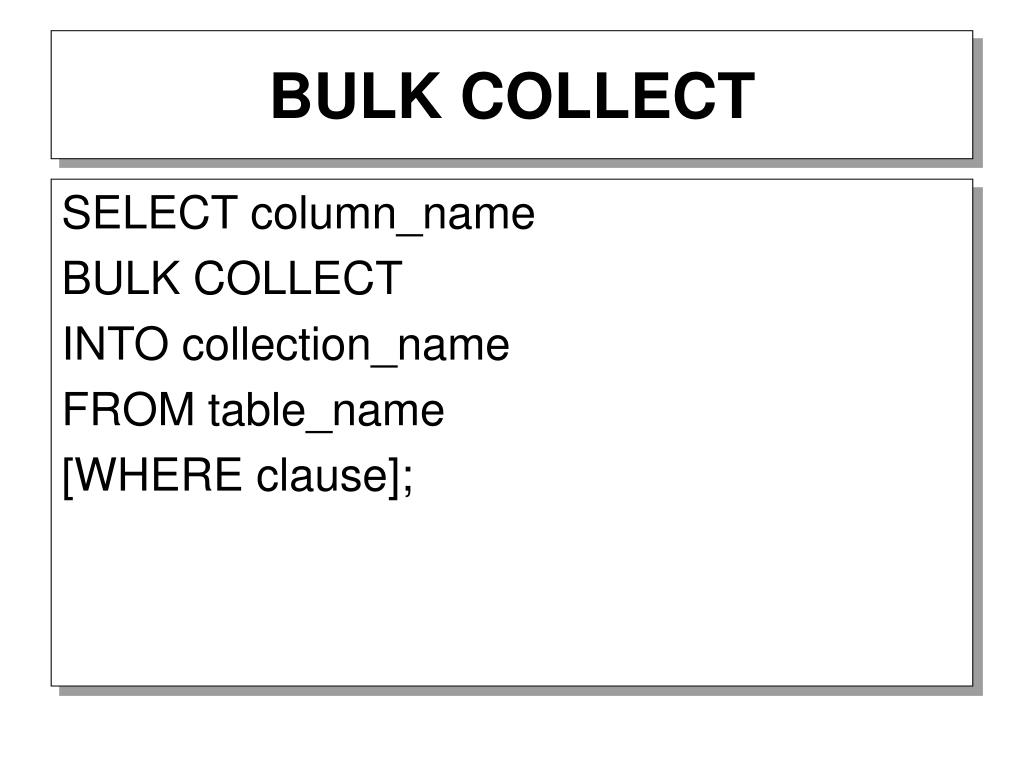Introduction To Plsql Bulk Collect In Oracle Database Rebellionrider How Use Clause With Select
1 Given the following Oracle function: CREATE or REPLACE FUNCTION foo (id NUMBER, category VARCHAR) RETURN CHAR IS TYPE MY_ARRAY2 IS TABLE OF NUMBER; MY_ARRAY MY_ARRAY2; BEGIN SELECT my_id BULK COLLECT INTO my_array FROM my_table RETURN ( CASE WHEN category = 'FOO' AND (id member of MY_ARRAY) THEN 'Y' ELSE 'N' END ); END;

Top 9 oracle bulk collect insert in 2022 Gấu Đây
BULK COLLECT is one of the way of fetching bulk collection of data. With Oracle bulk collect, the PL/SQL engine tells the SQL engine to collect many rows at once and place them into a collection. During an Oracle bulk collect, the SQL engine retrieves all the rows and loads them into the collection and switches back to the PL/SQL engine.

Introduction To Plsql Bulk Collect In Oracle Database Rebellionrider How Use Clause With Select
A bulk collect is a method of fetching data where the PL/SQL engine tells the SQL engine to collect many rows at once and place them in a collection. The SQL engine retrieves all the rows and loads them into the collection and switches back to the PL/SQL engine. All the rows are retrieved with only 2 context switches.

Oracle PL/SQL BULK COLLECT
The bulk_collect.sql script defines a collection with the same rowtype as the test table. It then populates the collection by manually extending and setting the values of the rows. Finally it populates the collection using a bulk operation. The output from this script is shown below. SQL> @bulk_collect.sql.

Oracle PL SQL Learn Bulk Collect and FOR ALL Bulk Collect and LIMIT With Example YouTube
In PL/SQL, the BULK COLLECT feature is used to enhance the performance of SQL queries by fetching multiple rows at once and storing them in collections ( arrays or nested tables) rather than processing one row at a time. This reduces the number of context switches between the SQL engine and the PL/SQL engine, resulting in improved efficiency.

PL/SQL Bulk Collect With LIMIT Clause In Oracle Database RebellionRider
Use BULK COLLECT with the SELECT statement in PL/SQL to retrieve rows without using a cursor. This example selects all rows from the departments table for a specified location into a nested table, then uses a FOR LOOP to output data.

Bulk Collect/Sql/Oracle/Sql Interview science YouTube
Tutorial Bulk Processing with PL/SQL Description Learn how to make the most of the bulk processing features of PL/SQL: BULK COLLECT and FORALL. Be sure to run the setup code before trying to execute code in the modules. And you can re-run that setup code at any time if you'd like to reset the employees table to its "original" state.

Oracle PL/SQL BULK COLLECT
PROCEDURE process_all_rows IS TYPE employees_aat IS TABLE OF employees%ROWTYPE INDEX BY PLS_INTEGER; l_employees employees_aat; BEGIN SELECT * BULK COLLECT INTO l_employees FROM employees; FOR indx IN 1 .. l_employees.COUNT LOOP analyze_compensation (l_employees (indx)); END LOOP; END process_all_rows;
Bulk data processing with BULK COLLECT and FORALL in PL/SQL
Here we are executing our SQL query using Bulk Collect into with Execute Immediate. On execution, the Execute Immediate statement will execute the SQL query. And 'Bulk Collect Into' clause will store all the data returned by it into the collection nt_fname. Third we have a 'For loop'.

What Is Bulk Collect How And Why Do We Need To Use It Oracleappsdna Gambaran
BULK COLLECT Bulk binds can improve the performance when loading collections from a queries. The BULK COLLECT INTO construct binds the output of the query to the collection. To test this create the following table. CREATE TABLE bulk_collect_test AS SELECT owner, object_name, object_id FROM all_objects;

Introduction To Plsql Bulk Collect In Oracle Database Rebellionrider How Use Clause With Select
"BULK COLLECT Clause" for information about retrieving query results into a collection "Collection Variable Declaration" for syntax and semantics of collection type definition and collection variable declaration Record Topics Record Variables

How To Use PL/SQL Bulk Collect Clause With FETCH INTO Statement RebellionRider
Oracle Bulk Collect is recommended to use for handling large number of rows. Note that, the larger the number of rows you will collect, the more performance improvement you will achieve. For better understanding take a look at the examples bellow. 1. Bulk Collect can be coded without CURSOR loop, but only for small number of records.

Oracle PL/SQL BULK COLLECT
bulk collect in oracle Ask Question Asked 12 years, 2 months ago Modified 12 years, 2 months ago Viewed 6k times 2 How to query bulk collection? If for example I have select name bulk collect into namesValues from table1 where namesValues is dbms_sql.varchar2_table. Now, I have another table XYZ which contains name is_valid v h

PPT Oracle 8i PowerPoint Presentation, free download ID3195900
BULK COLLECT: These are SELECT statements that retrieve multiple rows with a single fetch, thereby improving the speed of data retrieval. FORALL: These are INSERT, UPDATE, and DELETE operations that use collections to change multiple rows of data very quickly.

Bulk Collect With Execute Immediate Of Dynamic SQL In Oracle Database RebellionRider
You can use the BULK COLLECT INTO clause with the EXECUTE IMMEDIATE statement to store values from each column of a query's result set in a separate collection. You can use the RETURNING BULK COLLECT INTO clause with the EXECUTE IMMEDIATE statement to store the results of an INSERT, UPDATE, or DELETE statement in a set of collections. FETCH

Oracle Bulk Collect, Part I YouTube
In the Oracle database, there is an area that runs the SQL code (SELECT, UPDATE, etc) and an area that runs the PL/SQL code (LOOP, IF, etc). Whenever a procedure or function needs to switch between these two areas, it's called a context switch.. BULK COLLECT: a clause to let you fetch multiple rows into a collection; FORALL: a feature to.